
PlatanusPLAT-ən-əss is a genus consisting of a small number of tree species native to the Northern Hemisphere. They are the sole living members of the family Platanaceae.
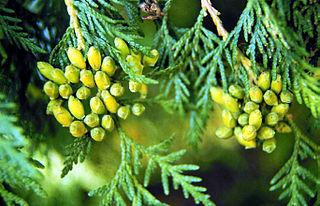
Thuja occidentalis, also known as northern white-cedar, eastern white-cedar, or arborvitae, is an evergreen coniferous tree, in the cypress family Cupressaceae, which is native to eastern Canada and much of the north-central and northeastern United States. It is widely cultivated as an ornamental plant. It is not to be confused with Juniperus virginiana.

Pinus occidentalis, also known as the Hispaniolan pine or Hispaniola pine, is a pine tree endemic to the island of Hispaniola.
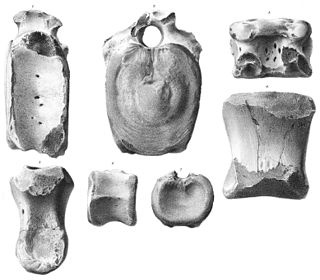
Thespesius is a dubious genus of hadrosaurid dinosaur from the late Maastrichtian-age Upper Cretaceous Lance Formation of South Dakota Size 4,8(16ft) Height 18(60ft) and 18 Tons

Salix udensis is a species of willow native to northeastern Asia, in eastern Siberia, northeastern China, and northern Japan.

Melampsora lini is a species of fungus and plant pathogen found in Ireland and commonly known as flax rust.
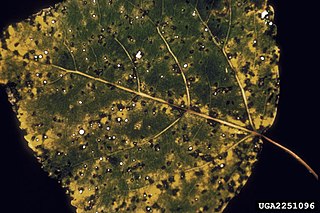
Melampsora medusae is a fungal pathogen, causing a disease of woody plants. The infected trees' leaves turn yellowish-orange. The disease affects mostly conifers, e.g. the Douglas-fir, western larch, tamarack, ponderosa, and lodgepole pine trees, but also some broadleaves, e.g. trembling aspen and poplars. Coniferous hosts are affected in late spring through early August, and trembling aspens and poplars from early summer to late fall. It is one of only two foliage rusts that occur naturally in British Columbia.
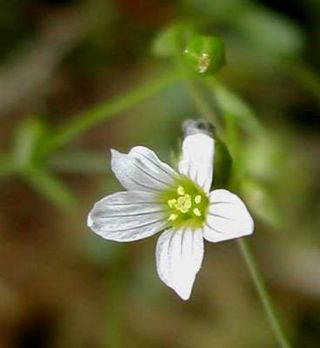
Linum catharticum, also known as purging flax, or fairy flax, is an herbaceous flowering plant in the family Linaceae, native to Great Britain, Iceland, central Europe and Western Asia. It is an annual plant and blooms in July and August.
The western shrew mouse is a species of rodent in the family Muridae. It is found in West Papua, Indonesia and Papua New Guinea.

The grey-backed hawk is an Endangered species of bird of prey in subfamily Accipitrinae, the "true" hawks, of family Accipitridae. It is found in Ecuador and far northern Peru.

The Spanish mole is a species of mammal in the family Talpidae. It is found in Spain and Portugal.
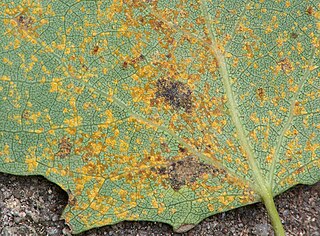
Melampsoraceae are a family of rust fungi in the order Pucciniales. The family is monotypic, containing the single genus Melampsora, which contains about 90 species.

Saxifraga hirculus is a species of saxifrage, commonly called marsh saxifrage, yellow marsh saxifrage, or bog saxifrage. It is a perennial herb with yellow flowers and red stem, 5–30 cm high, found on bog landscape.
Arbutus occidentalis or the Mexican Madrone is a small tree species in the heath family, that is endemic to Mexico. It is only known from a few areas in Western Mexico where it grows on rocky slopes. It produces red edible berries that are valuable food to wildlife.

"Occidentali's Karma" is a song performed by Italian singer Francesco Gabbani. The song was released as a digital download on 10 February 2017 through BMG Rights Management as the lead single from his third studio album Magellano (2017). The song was written by Gabbani, Filippo Gabbani, Fabio Ilacqua, and Luca Chiaravalli. It won the Sanremo Music Festival 2017 and represented Italy in the Eurovision Song Contest 2017, finishing in sixth place.
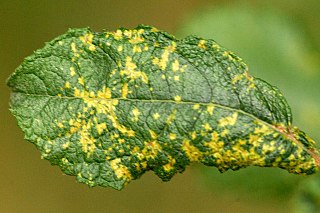
Melampsora caprearum is a fungal pathogen which causes galls on willows. Also known as a rust fungus, it was first described by Felix von Thümen in 1879.
Melampsora amygdalinae is a fungal pathogen and part of the division Basidiomycota. It is known as a rust fungus that is host specific. M. amygdalinae commonly infects willows of the genus Salix. This fungus was first discovered in 1909 by Heinrich Klebahn who was a professor of soil biology in Hamburg. Neimi at el. explain how the pathogen occurs throughout the whole distribution of the host, and the small natural populations are an area of interest. This rust fungus is annual and autoecious, which references the fungus spending its entire life in a single host.

Melampsora pulcherrima is a Mediterranean plant pathogen. It is a rust that infects Mercurialis annua, causing galls, pycnia, and aecia over leaves and stem in winter, seen as a golden yellow swelling over several centimeters, as well as Populus alba, causing uredia and telia on leaves from spring until autumn.
Melampsora hirculi is a pathogenic fungus in the order of Pucciniales or rust fungi. It is causes disease in Saxifraga hirculus.














